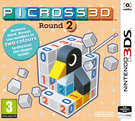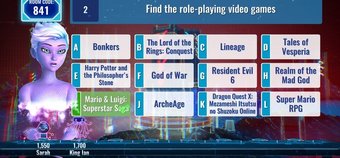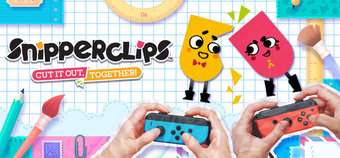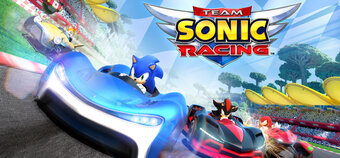Ever since Nintendo's first touch screen console, the DS launched, Picross has been something of a Nintendo institution - and one of our favourite time wasters. If you're ever stuck on the bus, on a train, or in a waiting room, there's no better way to pass the time - and keep your brain engaged - than by trying to solve a picross puzzle.
The only problem is, it's more than a little bit tricky to explain what picross actually is. Kind of like a do-it-yourself mosaic, the original Picross presented you with a grid, and plonked a load of numbers next to each line, which told you how many squares you'd need to knock out of each to form the picture. All you had to do was use a process of elimination, and some very specific logic to figure out which squares you could safely remove, cross-referencing the horizontal and vertical lines as you went. Picross 3D, meanwhile, took that very same concept, but applied it to a three dimensional shape instead, letting you chisel away at a block made of cubes to form some very fancy 3D models.
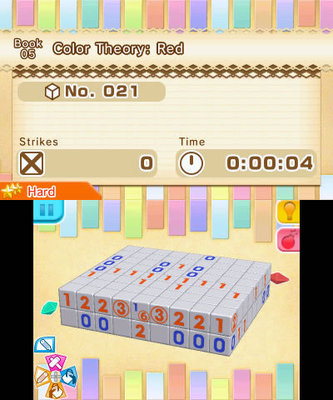
Take your time, there's no rush!
If you've played either the last Picross 3D game on the DS, or any of the earlier 2D Picross games, you'll know exactly what to expect from Picross 3D Round Two.
Just think of yourself as a modern day Michelangelo (no, not the turtle), chiselling away at a block of marble to turn it into something beautiful. Only rather than having to rely on your keen artistic sense and eye for detail, it's kind of more like a "sculpting by numbers", where all you really need to do is follow the handy numerical instructions to make your own masterpiece. Depending on the level you're playing, you could be crafting a planet, a dog, the letter A, or one of any number of cute animals, funky objects, or random vehicles - and you'll never know quite what you're going to get until you've finished chiselling away!
On starting each level, you'll be presented with a block, which is peppered with numbers in two colours - orange and blue. As before, the numbers show you how many blocks need to be coloured in on that line, and what colour you'll need to colour them in - and it's up to you to use an industrial sized dose of logic and critical reasoning to figure out where they might go, before getting rid of any blocks that are left over.
The first step in any puzzle is to chisel away all the rows that have a zero on, as there's obviously nothing to colour in there - but things quickly get a lot trickier from there on in. Luckily, any tricks you may have learnt from the earlier picross games still work in Picross 3D, and the thought process you'll need to use isn't actually too different - for the most part, it's simply a (rather complex) process of elimination, made all the more mind-boggling by Picross 3D Round 2's more unusual rules.
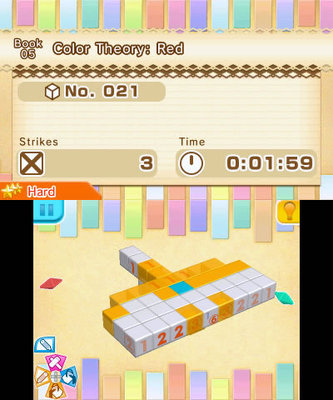
When the number fades out, that shows you've coloured in everything you need to on that row - best chisel the rest away!
It's probably easiest to explain how Picross 3D works by giving you a quick example. If you have a row of 5 blocks, with a number four plastered on the end, you can safely assume that at least the middle three need to be coloured in - no matter where the four blocks go, the three in the middle will always be coloured in. If it's a number four in a circle, however, things suddenly get a lot harder. The circle signifies that the four blocks you'll need to colour in on that line are split into two groups - but it doesn't tell you how they divide. It could be one then three, two then two, or three then one - and you don't know where the gap's going to come.
Numbers with a square around are a brand new feature, and make things even more complex - this lets you know that the blocks you need to colour in are divided up into (a minimum of) three groups - could be three, four, five, or any other number - and figuring out where they need to go can often, but not always, be more than a little bit tricky. If you've got the aforementioned row of five blocks, and they have a number three in a square slapped on the end, for example, it's easy - as your three can only divide into three groups of one each, there's just enough room to paint them all in, with a space in-between. It's when you've got a row of ten, and a four or five in a square that things get a lot more complex.
One of the things you'll notice about Picross 3D is that often - unlike normal Picross - not every row, or column, has a number plastered on the side. This, by all accounts, is designed to make the game harder, and force you to deploy your brain if you want to figure out which squares need to be coloured in, and which need to be removed. To complete even an average puzzle, you'll need to do an immense amount of rotating, cross referencing, and visualising different patterns, mentally trying out different combinations of blocks until you've managed to prove that only one possibility will work. Even finding just the one block you can colour in often makes a huge difference, as it'll often let you cross off another few possibilities, and figure out where yet more blocks go.
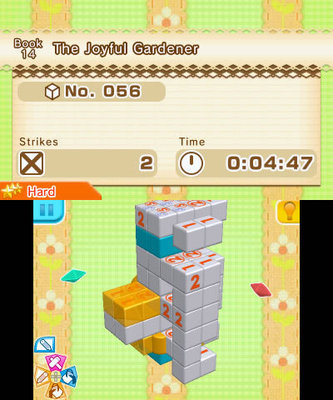
Some puzzles see you dealing with some rather unusual shapes
The technicalities of Picross 3D may be tricky to describe, but once you really get playing, it feels natural. Picross 3D Round Two undoubtedly has one heck of a learning curve - this is a game that's anything but pick up and play simple (and Nintendo know it, as you'll be able to tell by the amount of instructions). But it's also incredibly rewarding. Because it's so tricky, figuring out even a fairly basic puzzle leaves you with an immense amount of satisfaction - especially if you manage it without making any mistakes.
Unlike 2D Picross, you don't have a maximum time limit in which you'll need to complete the puzzles here either, and making a mistake won't penalise your time - instead, you'll simply earn less points when you finish the puzzle. Completing a puzzle will reward you with a number of points depending on how long you took, how many mistakes you made, and what difficulty you're playing on, with a multiplier in effect for the harder difficulties. Make no mistakes, and finish the puzzle quickly, and you'll earn points, which translate into a certain type of jewel as a reward - but more on this later.
Luckily, for the novice, there's plenty to give you a helping hand as you're learning the ropes, too. The game kicks off with an extensive series of tutorials, and periodically gives you refresher stages, designed to keep your deduction skills sharp. In a deviation from the norm, you also have an unlimited amount of hints to use in game, with no penalty for doing so. If visualising things in 3D is a bit tricky, you can also use two handy sliders to view "slices" of the 3D shape, effectively turning the slice into a bog standard 2D picross puzzle. And, in another unusual move, there's even a choice of three difficulty levels too, with Easy giving you more, simple hints, and Hard giving you fewer, more complex hints, that reveal the squares in a more challenging way.
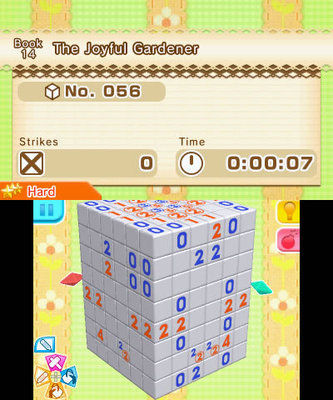
It's got to be a gardener, surely?
In fact, perhaps the only real issue we have with Picross 3D: Round Two is how you unlock the puzzles. Divided into "books" of puzzles, each based around a particular theme, you'll need to achieve certain goals in order to unlock them - and while many of these are fairly straightforward (e.g., earn more than 1800 points in total), some are a little bit more complex. One type of goal you'll need to meet to unlock several of the game's books is to "earn 30 jewels that are this type or better" - the only issue being, the game doesn't actually give you a hierarchy of jewels, so you won't have a clue whether the jewels you're currently getting are better, worse, or equivalent.
Still, weird unlock system aside, there's a lot to like about Picross 3D Round Two. With over 300 incredibly rewarding puzzles to solve, there's plenty to keep you busy here - and like the games that came before it, there's something innately relaxing about it too. Whether you're looking for a new puzzling challenge, or a way to escape the stress and find your Zen, Picross 3D Round Two is well worth a look - perhaps the only real surprise is that it's taken Nintendo this long to make a sequel!
Format Reviewed: Nintendo 3DS


